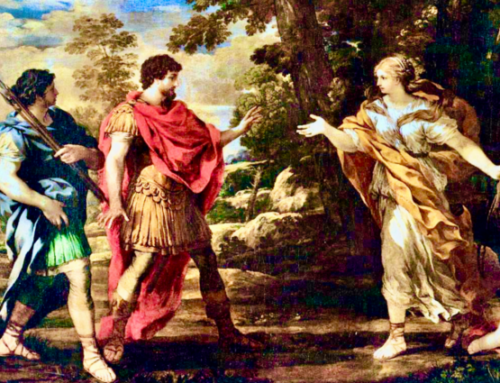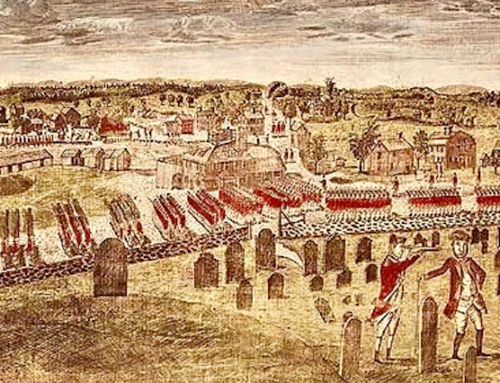 The terribly fragile fabric of society has revealed itself all too frequently in recent months. Really, for a more than a year now, the social fabric of Western and American society has been rent by sporadic if not quite predictable violence at home and abroad. Whether it’s terrorists driving trucks into innocent crowds in the south of France, or so-called anarchists burning the limousine of a Muslim immigrant during a peaceful transition of power in our nation’s capitol.
The terribly fragile fabric of society has revealed itself all too frequently in recent months. Really, for a more than a year now, the social fabric of Western and American society has been rent by sporadic if not quite predictable violence at home and abroad. Whether it’s terrorists driving trucks into innocent crowds in the south of France, or so-called anarchists burning the limousine of a Muslim immigrant during a peaceful transition of power in our nation’s capitol.
Somewhere, Edmund Burke said something to the effect that what takes several centuries to build can be brought down in a matter of hours.
This semester, I have the grand privilege of teaching the history of the American Civil War, an upper-level history course I share with one of my other colleagues, David Raney. This was the first course I taught at Hillsdale, back in the Fall of 1999, and I have never once grown tired of it or ceased to feel the honor of teaching it. Indeed, every lecture makes me realize just how sacred the war was and how much of a glorious burden I carry by teaching it.
As many readers of The Imaginative Conservative already know, nearly every male attending Hillsdale College in the spring of 1861 volunteered to fight in several Union regiments, but most particularly in the Second, Fourth, and Twenty-Fourth Michigan infantry regiments. Many Hillsdale men gave their lives on the first and second days of the Battle of Gettysburg. Regardless of my own views on the righteousness of the Union or Confederate causes, I have an immense respect for the average soldier on each side. Far from fighting for or against slavery, most troops fought to defend what they believed to be a greater and better republic, a republic that lived up to the many sacrifices of their fathers and grandfathers. As their letters and diaries so clearly reveal, each side saw itself as defending the honor of the American Founding Fathers, living up to the blood and treasure given in the American War of Independence.
As I remind my students, I, as a professor, will never have the distinction of being a fellow classmate of these great warriors of 1861-1865.
I am, however, reminded of my own alma mater. On the second day as a freshman at the University of Notre Dame, my dorm rector led his freshmen men on a tour of campus, pointing out the lesser-known nooks and crannies of that venerable South Bend campus. I’ll never forget the moment that he led us into Sacred Heart Basilica, taking us into and through the eastern entrance. Above the door, etched in the limestone, is “God, Country, and Notre Dame.” To the right of the door, at eye level, is a bronze plaque listing all the Notre Dame men who died in the First World War. As one walks through the entrance and looks up, he notices a terribly shabby and rusty chandelier. Far from being tacky, it is one of the most sacred things in the entire basilica. The chandelier is made from the helmet of a Notre Dame soldier who died a century ago in the far-off wastes of the trenches of northern Europe.
Of everything I experienced in my four glorious years at Notre Dame, that one moment best summed up the meaning of “God, Country, and Notre Dame” for me, and I have always been immensely proud to be a graduate of an institution that could foster and promote such character. In those few moments, Father King, our rector, revealed to me the essence of goodness and sacrifice, the eternal linkage between the two, and the demands that a healthy republic makes upon its citizens.
As inadequate a vessel as I am, I do my very best to stress these very truths to my Hillsdale students. And, yet, Notre Dame isn’t Hillsdale. From the very first day this college opened in Michigan, Hillsdale was unequivocally color-blind and gender-neutral. What does this mean for a freshman in 2017? Quite a bit, understandably. How to convey this story and character of virtue to each new and rising class, however, is not so easy. Nor, of course, should it be. The student of 2017 must, somehow, connect with the student of 1861, closing that expanse of time, making it and understanding it as something sacramental and holy, a soul speaking to a soul across a century and a half.
As one walks onto Hillsdale’s campus, he is met by an 1898 statue of a Civil War soldier, a representation of all Hillsdale students who served honorably in that noble and tragic moment in our republic’s history, the American War Between the States. Even our statue of Abraham Lincoln bows to honor the soldier who gave everything to protect the honor of the republic. Every spring, I take my freshmen out to that statue of the soldier. As we stand around its base, I read to them Bruce Catton’s description of the Twenty-Fourth Michigan Infantry—one of the five regiments of the Iron Brigade and made up significantly of men from Hillsdale College and Hillsdale County—on the first afternoon at Gettysburg. Though desperately outnumbered, the Twenty-Fourth took a position on the western road leading into the little Lutheran community. They stood resolutely against the invading forces, standing as once Leonidas and his 300 had stood. Within roughly twenty minutes, the Confederates had cut close to eighty percent of the regiment to pieces, but they had also become convinced that the high ground—Little Round Top and other higher areas in the region—would be impossible to take. As such, they not only hesitated, they halted any advance.
Over the next forty-eight hours, on days two and three of the battle, the Confederates did everything they could to claim the ground that the men of Hillsdale, on day one, had tried so hard to deny them.
My office at Hillsdale is Delp 403, and the entire fourth floor is dedicated to the students who died on July 1, 1863—day one of Gettysburg.
Not being a graduate of this college, but merely a professor, I ask my students why their fellow students of the 1860s were willing to give so much?
For a secure financial future? For unguarded power? For a decadent life?
Obviously, I don’t have to provide the answer explicitly.
The men of Hillsdale College did that already, far to the east of this little place—a place equally filled with trees, hills, and dales.
The Imaginative Conservative applies the principle of appreciation to the discussion of culture and politics—we approach dialogue with magnanimity rather than with mere civility. Will you help us remain a refreshing oasis in the increasingly contentious arena of modern discourse? Please consider donating now.
The featured image is Adolph Weinman’s Union Soldiers and Sailors’ Monument, erected 1909. Located in the public parks of Baltimore. It is in the public domain and appears here courtesy of Wikimedia Commons.







As was pointed out by a wonderful Priest, Don Juan of Austria was appointed by the then Pope to command the Christian forces in the Battle of Lepanto, and get this, at the age of 23, an age not too much older than most of the ungrateful rioters and protesters and PC aggrieved students who shame themselves and dishonor the very men who have sacrificed so much, their lives, for the gift of this nation under God. We can be assured that the evil of these times will pass, that the good God has in mind will come about, and to the extent we join the sacrifice, we restore our nation’s honor in honoring Him who has invited us to follow.
700 000 men died in the American civil war,,,,how noble was it…? It is suggested that war began after northern bankers decided to levy higher taxes against the prosperous South, it’s wealth secured with cotton farming and the fibre fuelling the British industrial revolution…i.e. with textile manufacturing.
I have become enamored with another connection between Hillsdale and Notre Dame. The St. Joseph River is born in Hillsdale, whence no water is received but only pours outward. The St. Joseph, naught but a babe, flows past Hillsdale college carrying something downstream. Several hundred miles later, and much greater in girth and volume, the St. Joseph makes a great, wide turn, namesake for that city South Bend. There is a connection.